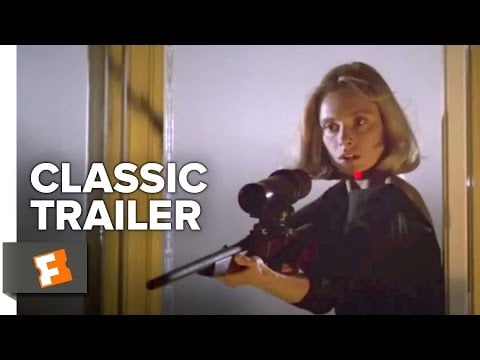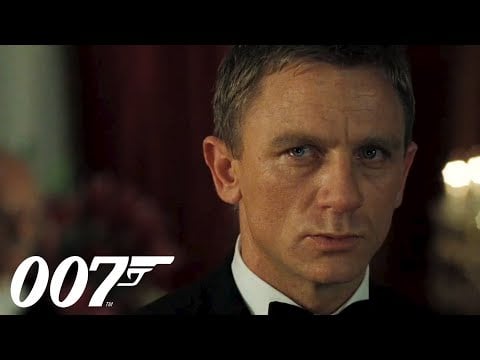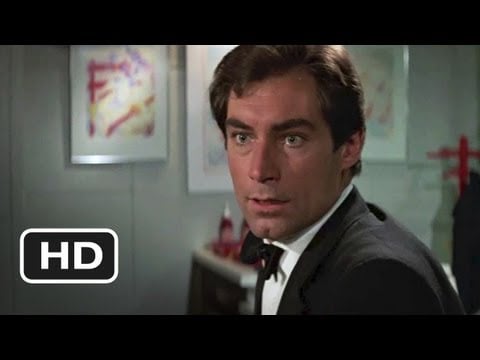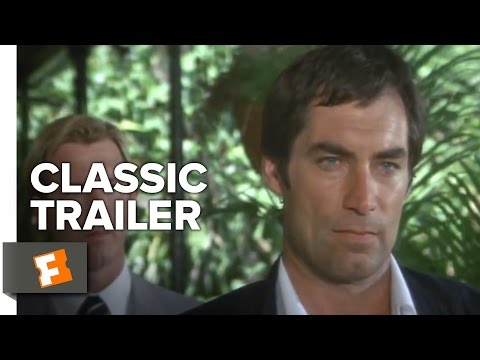Has enough time gone by that we can finally give Timothy Dalton his due at playing James Bond?
While the Ian Fleming-created franchise, one of the longest running in cinema, is currently in a hibernation period, and the search for The Next 007 is currently ongoing, I’d like fans to take another look at the fourth actor to play James Bond.
(Well, the fifth, if you count Barry Nelson in the 1954 “Casino Royale” TV movie).

John Glen’s “The Living Daylights” (1987) was Dalton’s first vehicle as Bond, after Roger Moore stepped away from the unliked but wildly popular “A View to a Kill” (1985) and series icon Sean Connery had embarked on the enormously successful third act of his long film career.
Dalton was a respected but unknown film and theater actor (his appearance in the 1980 cult classic “Flash Gordon” was arguably his most well-known turn prior to 007).
Once Dalton exited the role in ’89 and the Pierce Brosnan era kicked in, it gave fans a chance to grouse about the “dark, moody” quality that Dalton brought. The actor always shows up on lists of the least liked in the franchise to have played Bond.
For longtime fans of Fleming and anyone who truly appreciated Dalton’s two 007 vehicles, it’s time to consider that Dalton belongs in the company of the Best of Bond…if not the very top spot. Before you let that get you all shaken and stirred, it might be time to revisit Dalton’s excellent turn in “The Living Daylights.”
RELATED: Why Roger Moore Was the Right 007 for Our Times
In the great pre-title opener, Dalton’s Bond is a participant in a NATO training exercise that is infiltrated by Russians. Not for the first time during the sequence, Bond falls from above and enters the frame like a clipped Icaurus, landing atop a fancy yacht, where a woman is declaring into an early cell phone,
“It’s all so boring here in Morocco…nothing but playboys and tennis pros…if only I could find a real man.”
Yet, when Bond turns up, he appears amused instead of aroused by sex (unlike his predecessor Roger Moore, who played the character like an insatiable horn dog).
It begins in Czechoslovakia, as this USSR-era Bond is assigned to rescuing General Koskov, played by Jeroen Krabbe. Bond then encounters Olivia D’Abo’s Kara, a KGB assassin and cellist. Bond poses as Koskov’s friend, in order to obtain information from Kara about him.
It brings to mind the moment I saw this in the theater with my parents and I turned to my mom and asked, “Why is James Bond kissing the Bad Guy?” My Mom’s reply – “We don’t know, we’re trying to figure that out.” There’s also a fake defector. The plot is really confusing.
FAST FACT: “The Living Daylights” earned $51 million at the U.S. box office. Its predecessor, Roger Moore’s “A View to a Kill,” generated $50 million.
The villains are silly, with Krabbe (who has shined far more before and since) as Koskov and joined by Necros, a Simon de Bond lookalike who often strangles opponents to death with a Walkman head phones, played by character actor Andreas Wisniewski.
John Rhys Davies has a great fake death scene and D’Abo plays Kara as the damsel in distress that so many “Bond girls” of that era were, as the strong female characters in the series wouldn’t arrive until the 1990s. D’Abo’s’s last line and the film’s closer is Kara exclaiming, “Oh, James!”
This is a transitional Bond film, as veteran director Glen, franchise composer John Barry and character actor MVP’s Bernard Lee (as M) and Desmond Llewelyn (as Q) are still on hand. We meet the new Moneypenny, played by Caroline Bliss (replacing Lois Maxwell), who fails to seduce Bond with her Barry Manilow collection (I’m not kidding).
We briefly run in with Felix Leiter, played by one and done John Terry.

The stunts are doubly impressive for being CGI-free and so visibly dangerous. Yes, that’s real fire in one sequence, something you never see in movies anymore. Interestingly, both Dalton and Pierce Brosnan’s introductory moments have them dropping down to the Earth from high, like gods falling to Earth, symbolizing the actor’s career ascensions.
Barry’s drum-machine-enhanced orchestral score works and so does the cool title track from A-Ha (though it doesn’t live up to the MTV-injected heights of Duran Duran’s “A View to a Kill”). Maurice Binder’s cool title sequence, an overlapping of striking imagery, is devoid of the miasma of CGI that has dominated these portions lately.
Dalton is intense, dark, suave and mean. This is the Fleming character, minus the crackling charisma of Sean Connery, the what-am-I-doing-here affability of George Lazenby and the detached demeanor of a game show host that plagued the later installments of Roger Moore.
Dalton’s approach has a great deal in common with Daniel Craig’s, though even more so, as Dalton aims to make the character as plausible as possible. Even the signature “Shaken, not stirred” signature line sounds like a real drink order coming from him.

“The Living Daylights” is brisk and takes off immediately. The title comes from Bond’s observation about Kara, an incorrect assumption after grazing her from afar with a bullet: “Whoever she was, it must have scared the living daylights out of her.”
The main villain turns out to be an arms dealer played by Joe Don Baker, having a peculiar summer – he also played the head of secret agency that assigns Bill Cosby in the mega-turkey “Leonard Part 6,” which opened five months later. Baker’s cheerful nut is shown having a gallery of life-sized dummies of the likes of Hitler and Napoleon, except they all look like him.
Of the action sequences, there’s a great kitchen fight scene that doesn’t even involve Bond. My favorite is the car chase in 007’s extraordinary, gadget-stacked vehicle, which becomes a low-tech sled down a hill atop a musical instrument.
A villain’s fake passport name for Bond, their prisoner: Jerzy Bondon. Oh, the indignity.
At another point, Bond stabs a bag, tastes the knife and declares, “Opium.” I’m no narcotics expert and I realize it’s an old movie cliché to do this, but shouldn’t Bond be tripping out over a taste of opium?
There’s a lovely scene in Vienna and, because Bond only has eyes for Kara during the film (minus the yacht babe from the prelude), many have deemed this the “romantic” Bond entry. That’s not the case at all and I suspect anyone who states that hasn’t seen “The Living Daylights” since the 1980s.
RELATED: 5 Reasons the Bond Franchise Doesn’t Show Its Age
Yes, we see James Bond on a date (this is likely the first time 007 has exuded courtship since “On Her Majesty’s Secret Service”) and there’s a sweetness that Dalton portrays, but it’s just the character doing his job and playing the part. the way Bond comes onto Kara in the Ferris Wheel is aggressive by today’s standards but, all political correctness aside, felt uncomfortable in 1987.
There’s also the brutal moment much late on, when Bond tears the clothes off a woman (in front of her husband, no less) and orders her to stand nude and still, as a distraction, while he kills disarmed assailants.
It’s truly ugly business, akin to Sean Connery’s Bond strangling a woman with her bikini in “Diamonds Are Forever” (1971). I mention these moments not to condemn “The Living Daylights” but to affirm why Dalton is the best 007 and why this is one of the best in the series: for lack of a better word, James Bond is a real bastard.
Most of these films counter this with glamour, showmanship and sex appeal. However, 007 is an awful human being and neither Dalton nor “The Living Daylights” romanticizes him.
Yes, there’s something enticing about playing a man in control of every situation, able to speak every language, physically and mentally capable of coming out on top (pun intended) of every scenario. Yet, Bond is also ruthless, cruel and alone.
Sure, he looks great in a tux, has a one-liner ready and plays a mean game of Baccarat but he’s abhorrent, with a License to Kill to boot. Dalton gives us the clearest glimpse of what Bond is really like.
Whereas other actors have interpreted him, this is James Bond.
FAST FACT: Ian Fleming is best known for penning 12 James Bond novels. He also wrote the children’s book “Chitty Chitty Bang Bang,” which became the beloved 1968 film starring Dick Van Dyke, Sally Ann Howes and Benny Hill.
While “The Living Daylights” may sport the perfect Bond, it’s not the perfect 007 thriller. A big reason is the third act, which begins with 007 and Kara as prisoners in a Russian airbase in Afghanistan. This portion goes on too long, padding the 130-minute running time and losing focus, though that’s far from the worst thing about it.
Bond befriends Kamran Shah, a prisoner/desert warrior played by Art Malick (who later played the villain in “True Lies”). It turns out that Shah is the leader of the Afghan Mujahideen, who, history tells us, would later become the Taliban.
This sequence ends with Bond dropping a bomb on a Russian tank, while the Mujahideen on horseback praise him as he flies off. The angle of Bond assisting future terrorists is, oddly enough, the same regrettable plot twist that would be incorporated into “Rambo III” a year later.
Once 007 is airborne, the movie also regains its footing and hits us with an extraordinary stunt sequence, where Dalton’s stunt double has a fist fight with a henchman inside and outside of a military plane losing altitude.
Dalton returned to the role only once, in the ahead-of-its-time “License to Kill” (1989), which was heavy and violent enough to be the first 007 film to merit a PG-13 rating.

The poor box office of that film and contract negotiations falling through with Dalton led to the 007 films going on hiatus, until Brosnan stepped in and the films themselves became critic hits and box office blockbusters.
While the Brosnan films are as exciting and enjoyable, they are cheeky in the way the Moore films were and became campier with each entry. By the time we arrive on Brosnan’s 007 swan song, “Die Another Day” (2002), we get an ice castle and Bond driving an invisible car.
When Daniel Craig took over the role in 2006, many noted that the series was taking a welcome turn into tougher, grittier material…but the truth is that Dalton got there first, decades earlier.
It’s time to revisit “The Living Daylights,” dust off Dalton’s license to kill and consider that his ahead-of-its-time interpretation may not have lasted past the 1980s but has an edge that works even better today.
The post Was Timothy Dalton the Best, Most Accurate James Bond? appeared first on Hollywood in Toto.
from Movies – Hollywood in Toto https://ift.tt/smhW3yS

No comments:
Post a Comment